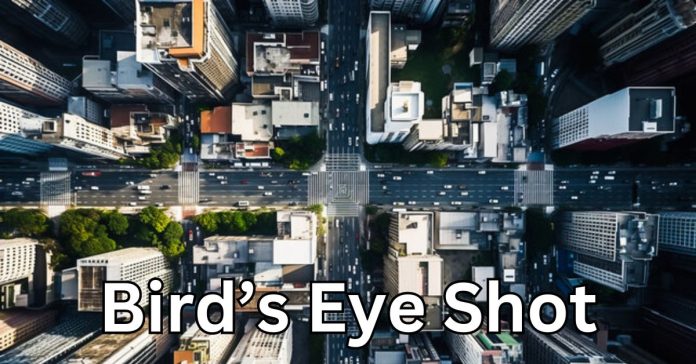In the realm of cinematography, where every frame tells a story and every angle conveys emotion, the bird’s eye shot stands tall as a powerful visual tool. This unique perspective, captured from high above the subject, offers filmmakers a multitude of creative opportunities to engage and mesmerize their audience. In this comprehensive exploration, we delve into the artistry and significance of the bird’s eye shot, uncovering its origins, techniques, and impact on storytelling.
Bird’s Eye Shot in Cinematography:
Origins and Evolution:
The bird’s eye shot, also known as an aerial shot or overhead shot, traces its roots back to the early days of cinema. While its usage was initially limited due to technological constraints, advancements in camera technology and aerial photography have propelled it into mainstream cinematography.
One of the earliest instances of the bird’s eye shot can be found in the silent film era, with filmmakers experimenting with primitive forms of aerial cinematography using hot air balloons or fixed-wing aircraft. However, it wasn’t until the mid-20th century, with the advent of helicopters and drones, that filmmakers gained unprecedented access to capturing stunning aerial perspectives with ease.
Techniques and Execution:
Capturing a compelling bird’s eye shot requires meticulous planning, coordination, and technical expertise. From selecting the right vantage point to controlling camera movement, every aspect plays a crucial role in achieving the desired effect.
- Vantage Point: Choosing the perfect vantage point is essential to capturing a captivating bird’s eye shot. Whether it’s a helicopter, drone, or crane, filmmakers must carefully consider factors such as altitude, angle, and framing to convey the intended message effectively.
- Camera Movement: Dynamic camera movement adds depth and dimension to bird’s eye shots, enhancing their visual appeal. Techniques such as panning, tilting, and tracking allow filmmakers to navigate the landscape seamlessly, guiding the viewer’s gaze and establishing a sense of perspective.
- Composition: Composition plays a pivotal role in shaping the narrative and evoking emotional responses from the audience. By strategically framing the subject within the surrounding environment, filmmakers can create visually striking compositions that draw viewers into the scene and convey a sense of scale and proportion.
- Lighting and Color: Just like traditional cinematography, lighting, and color play a crucial role in enhancing the mood and atmosphere of bird’s eye shots. Natural sunlight, artificial lighting, and color grading techniques can be used to evoke specific emotions and enhance the visual storytelling experience.
Impact and Significance
The bird’s eye shot holds immense significance in cinematography, offering Filmmakers a versatile tool for storytelling and visual expression. Its ability to provide unique perspectives, convey scale, and evoke emotion makes it indispensable in a filmmaker’s arsenal.
- Enhanced Narrative: Bird’s eye shots can offer viewers a fresh perspective on familiar landscapes, revealing hidden details and insights that may not be apparent from ground level. Whether it’s showcasing the vastness of a landscape or highlighting the intricate details of a bustling cityscape, these shots can enrich the narrative and immerse viewers in the story world.
- Emotional Impact: From awe-inspiring vistas to intimate moments of human connection, bird’s eye shots have the power to evoke a wide range of emotions in viewers. By capturing scenes from a bird’s eye view, filmmakers can instill a sense of wonder, grandeur, or intimacy, depending on the context and subject matter.
- Visual Spectacle: Beyond their narrative and emotional significance, bird’s eye shots are inherently captivating due to their sheer visual spectacle. The sweeping vistas, dynamic camera movements, and intricate compositions create a mesmerizing visual experience that captivates audiences and leaves a lasting impression.
Certainly! Here are some examples of bird’s eye shots from notable films:
-
“The Shining” (1980) – Director Stanley Kubrick masterfully uses a bird’s eye shot to capture the iconic hedge maze scene. The overhead perspective adds to the sense of disorientation and claustrophobia as the characters navigate the labyrinthine corridors, heightening the tension and suspense.
- “The Lord of the Rings: The Fellowship of the Ring” (2001) – In this epic fantasy adventure directed by Peter Jackson, bird’s eye shots are frequently employed to showcase the vast and sprawling landscapes of Middle-earth. From the sweeping vistas of the Shire to the rugged terrain of Mordor, these shots help establish the scale and scope of the epic quest undertaken by the Fellowship.
- “Inception” (2010) – Director Christopher Nolan utilizes bird’s eye shots to stunning effect in this mind-bending thriller. One notable example is the gravity-defying fight scene in the hotel corridor, where the overhead perspective adds a surreal and disorienting element to the action, reflecting the dream-like nature of the film’s narrative.
- “La La Land” (2016) – Director Damien Chazelle employs bird’s eye shots during the film’s elaborate musical sequences to create a sense of spectacle and grandeur. In the opening dance number set on a Los Angeles freeway, the overhead perspective allows the audience to fully appreciate the choreography and scale of the performance.
- “The Grand Budapest Hotel” (2014) – Director Wes Anderson is known for his distinctive visual style, and bird’s eye shots feature prominently in many of his films. In “The Grand Budapest Hotel,” these shots are used to showcase the intricate set design and elaborate tracking shots, adding to the film’s whimsical and stylized aesthetic.
These examples demonstrate the versatility and impact of bird’s eye shots in cinema, from enhancing narrative depth to creating visually stunning moments that linger in the minds of audiences long after the credits roll.
Conclusion:
In conclusion, the bird’s eye shot stands as a testament to the artistry and innovation of cinematography. From its humble beginnings to its widespread adoption in contemporary filmmaking, this unique perspective continues to inspire and captivate audiences worldwide.
As technology advances and filmmakers push the boundaries of creativity, the bird’s eye shot will undoubtedly remain a timeless and indispensable tool in the filmmaker’s repertoire, shaping the way stories are told and experienced for generations to come.




